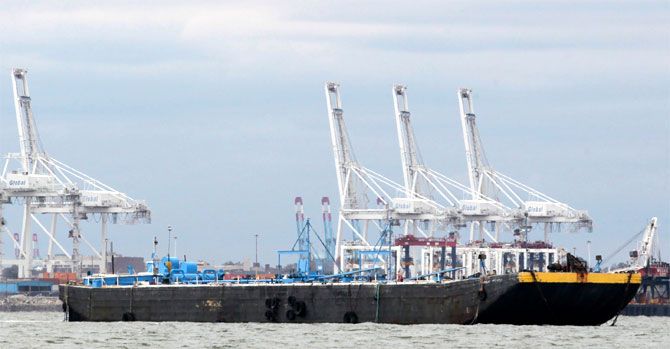Tehran plans to lift exports by 500,000 barrels per day

With Iran poised to resume usual business ties with the world under a historic nuclear deal, Tehran is set to target India, Asia's fastest-growing major oil market, and old partners in Europe with hundreds of thousands of barrels of its crude.
Iran expects the UN nuclear watchdog to confirm on Friday it has curtailed its nuclear programme, paving the way for the unfreezing of billions of dollars of assets and an end to bans that have crippled its oil exports.
Tehran plans to lift exports by 500,000 barrels per day (bpd) post-sanctions and gradually raise shipments by the same amount again, adding to a glut of global oil and likely putting more pressure on oil prices which have already dropped 70 per cent since 2014 to around $30 per barrel.
Iran has 22 Very Large Crude Carriers (VLCC) floating off its coast, with 13 fully or almost fully loaded, mapping data on Thomson Reuters' Eikon showed, carrying enough crude to meet India's import needs for almost a week.
A senior Iranian source close to supply negotiations said that the country - which has the world's fourth-biggest proven oil reserves - was targeting India as its main destination for crude.
"Indian crude demand is growing faster than other Asian countries. Like our competitors, we see this country as one of the main targets for Asian sales," said the official, who spoke on condition of anonymity.
Iran hopes to raise its exports to India by 200,000 bpd, up from the 260,000 bpd currently shipped under sanctions' restrictions, the official said.
At the right price, Indian refiners said they were keen to import more from Iran, as the country's demand for fuel soars on the back of 10 percent annual growth in car sales, a rate that is now faster than China's.
"We have a long-lasting relationship with Iran and post lifting of sanctions we will evaluate the scenario," said L K Gupta, managing director of India's Essar Oil.
"It makes sense to buy oil from nearby options (like Iran)," said H. Kumar, managing director of another Indian oil firm, Mangalore Refinery and Petrochemicals, but added "intake will depend on prices."
The Iranian official said there was not much room for major export increases to China, South Korea or Japan due to slowing demand and also because of a shift there towards more non-Middle East crudes.
A South Korean refinery source confirmed he did not expect a big increase in Iranian supplies, largely because of plentiful alternatives.
A Japanese refiner said that his firm could only take Iranian deliveries once it had insurance in place, which could take time.
Old European partners
Iran already trades limited amounts of oil mainly with Asian buyers legitimately under sanctions, but its crude exports have fallen to just over 1 million bpd, down from a peak of over 3 million bpd in 2011, pre-sanctions.
The Iranian official said Tehran planned to revive supply deals with European partners in order to ramp up exports.
Shipping industry association BIMCO confirmed that European clients would be among the first post-sanction clients.
"Former clients of Iran are the ones who are likely to return as buyers... Italy, Spain and Greece were the top EU importers in 2011," said Peter Sand, BIMCO's chief shipping analyst.
Following years of under-investment, Iran needs foreign cash to modernise its creaking oil industry.
Italy's ENI, Spain's Repsol and France's Total were some of the companies with the biggest delegations at a conference in Tehran last November, during which Iran published new terms for foreign oil investors.
Prospects for exports to the Americas, never a significant market for Iran, appear slim. Not only do U.S. sanctions unrelated to the nuclear issue remain in effect, but the region is already inundated with supply from soaring US and Canadian production.
Cut-throat market
In a cut-throat market, Iran may also find it difficult to sell its oil as the heavy grades it mostly offers are in low demand.
Latin American suppliers who produce similar heavy crudes have been seeking new buyers in Asia.
Within the Middle East, traders said Iran's main competitor would be Iraq, which has successfully returned to Asian markets in recent years, with exports rising above 3.5 million bpd.
In Europe, traders said Iran's crude would compete mainly with Russian Urals grades, which are competitively priced.
In China and India, strong passenger car sales are fuelling gasoline demand, while a slowdown in Asia's heavy industries means slower demand for diesel, which heavy crudes are often used to produce.
Iran does have light crudes, but needs them for itself to reduce gasoline imports. Either way, Iran adding to an oversupplied global oil market is bound to put more pressure on prices.
"With Iran's sooner return... there is still further downside risk to prices this quarter," Barclays bank said.
Photograph: Brendan McDermid/Reuters
Additional reporting by Florence Tan, Keith Wallis and Jacob Gronholt-Pedersen in Singapore, Meeyoung Cho in seoul, Osamu Tsukimori in Tokyo, and Amanda Cooper and Simon Falush in London












 © 2025
© 2025